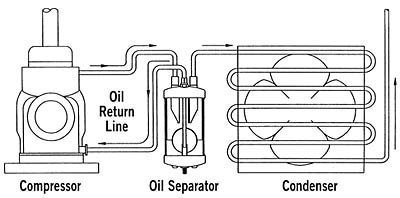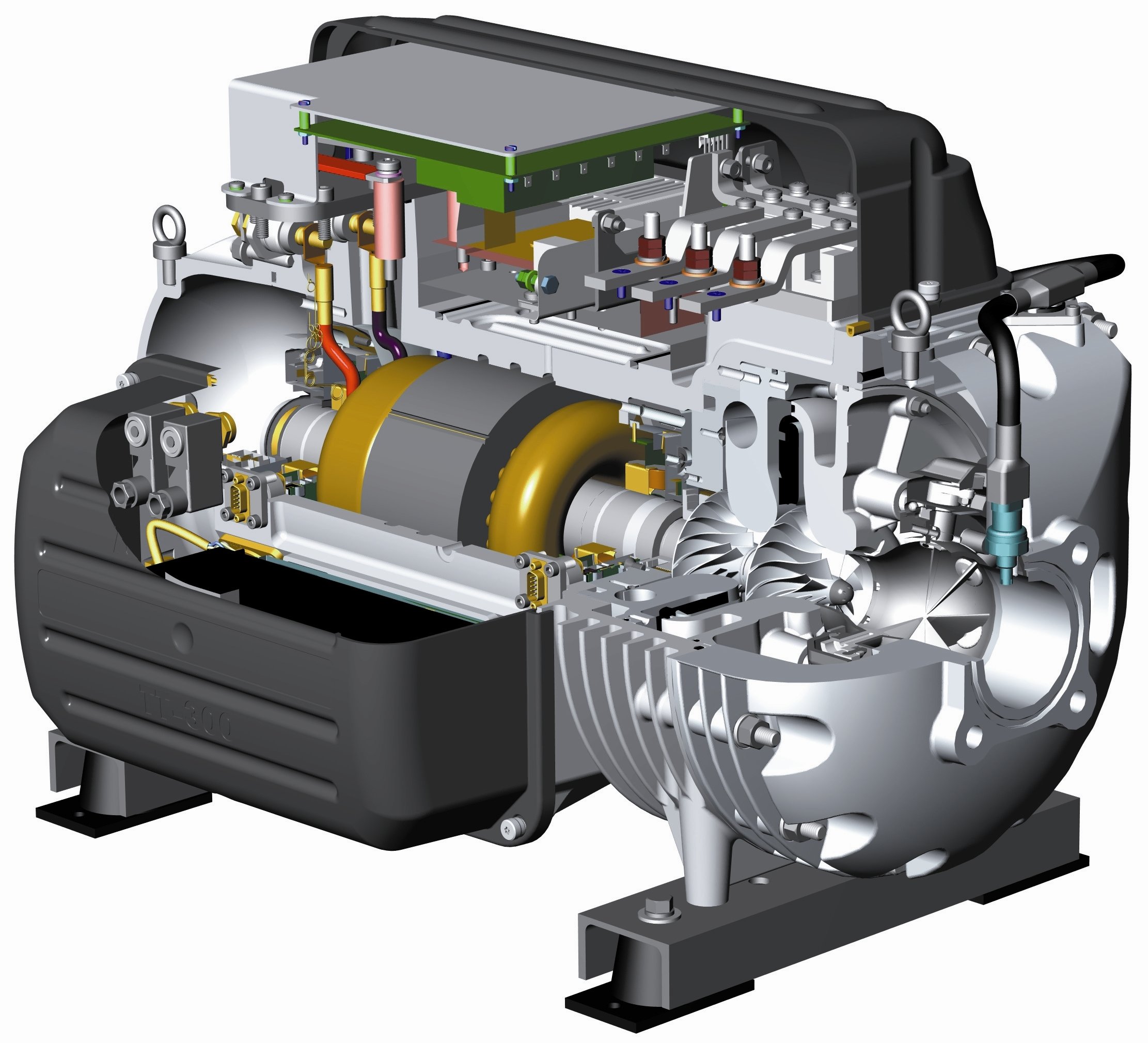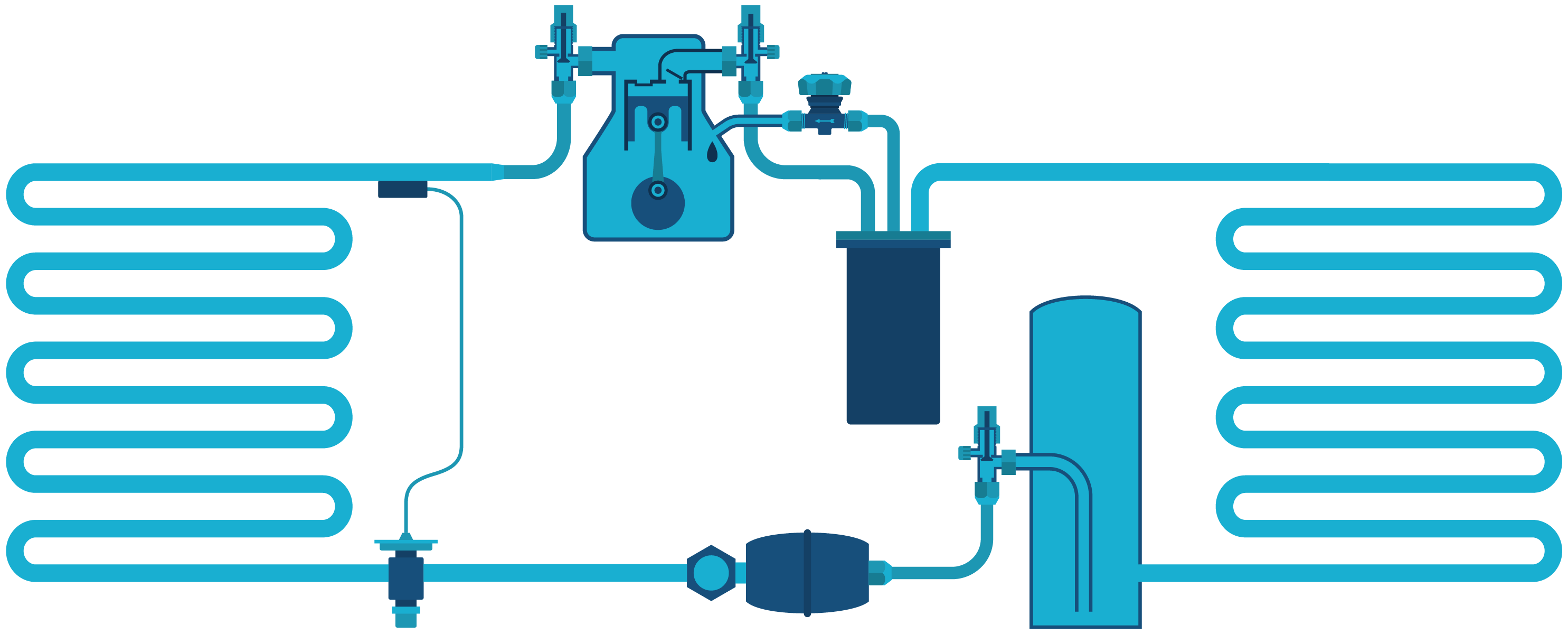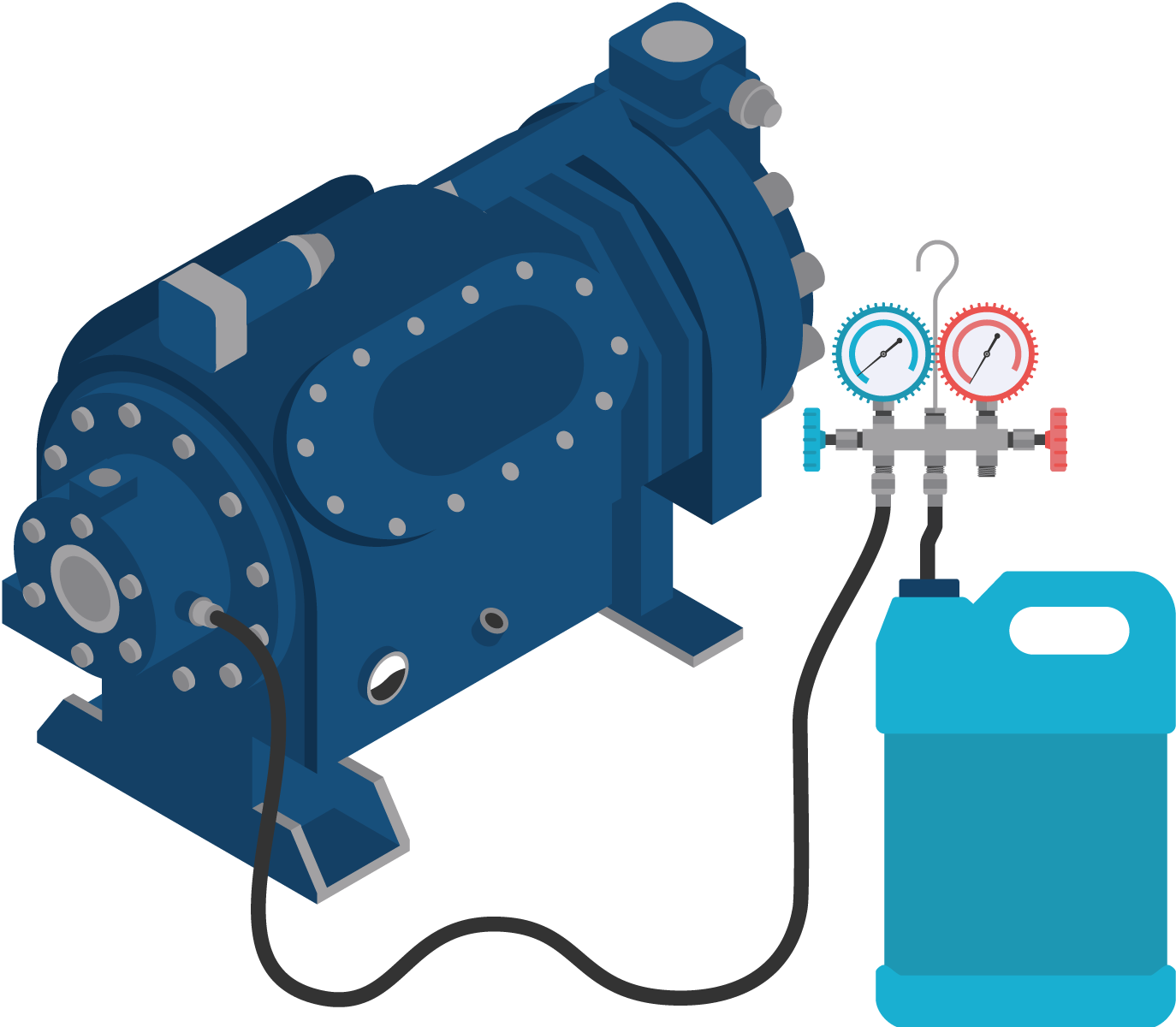Get Tech Tips
Subscribe to free tech tips.
Refrigerant Oil Basics

First, here's a quick summary of the role of oil in the refrigerant circuit:
The compressor requires oil for the lubrication of the moving parts in the compressor. We would keep 100% of the oil in the compressor if we could. However, that is generally unrealistic. So, we need to utilize oils and oil strategies that will circulate the oil through the system and return it to the compressor where it belongs regularly and continuously.

There are components called oil separators that can strip most of the oil from the discharge gas and return the oil to the compressor; these are often used on larger systems, and they are still less than 100% effective by themselves.

In VERY large systems, such as chillers, we are beginning to see oilless technologies with magnetic bearings like TurboCor from Danfoss (shown above), but these are still pretty rare in the field.
So, we are left with circulating oil through the system and returning it to the compressor as a regular part of A/C and refrigeration system operation under normal running conditions.
First, let's cover the oil considerations a service tech can easily diagnose and impact.
Technician Considerations
We are tasked with preventing liquid refrigerant from entering the compressor, which can cause more rapid and potentially catastrophic oil loss. This condition is called “flooding,” and it can occur while the system is running when the refrigerant superheat is allowed to stay at zero as it enters the compressor; zero superheat indicates the presence of liquid refrigerant mixed with the suction vapor.
A flooded start occurs during startup when liquid refrigerant is allowed to collect in the compressor, suction line, or even in the evaporator. These conditions can cause oil loss from the compressor and oil dilution, resulting in rapid compressor wear.
Preventing flooding is a significant part of oil management. It involves setting superheat properly and using other strategies, such as crankcase heaters, non-bleed expansion valves, and pumping down on the off cycle to help keep liquid refrigerant out of the compressor.

Another factor in lubrication is oil breakdown, which can occur at high temperatures. We should consistently monitor discharge temperatures exiting the compressor to avoid breakdown. The discharge line temperature shouldn't exceed 225°, equating to around 300° at the compressor discharge valves (on a reciprocating compressor). Monitoring discharge pressures will help ensure that the oil doesn't break down and “carbonize.” Now, that temperature varies based on the compressor type, system, and oil type. However, 225° is a generally accepted rule in the absence of a more detailed guideline.
On a properly functioning compressor, the mass flow rate (amount of refrigerant moving through the compressor) and the suction gas temperature are the primary factors that impact compressor discharge temperature. Often, high discharge temperatures occur when the suction pressure is low, superheat is low, and the compression ratio is high (high head pressure, low suction pressure). It also occurs when there is some combination of those issues.
Oil Return

Once the oil has left the compressor, it must circulate through the system and return to the compressor crankcase, and there are a few key factors that impact oil return:
- Oil/refrigerant miscibility (how well the oil mixes and moves with the refrigerant)
- Oil viscosity (oil thickness)
- Refrigerant velocity throughout the circuit
The oil being utilized should be suited to the refrigerant type and of the proper viscosity for the compressor and the temperature application. Refrigerant velocity should be maintained according to manufacturer recommendations. Low velocity will primarily be an issue in evaporator coils and suction lines when the suction pressure is lower than design due to improper tubing sizing, low evaporator load, metering device underfeeding, or undercharge.
Oil Quantity

Keep in mind that systems will need more oil when they have longer refrigerant lines and larger evaporators; more oil will be out in the “circuit,” meaning the system will need to contain more total oil. Technicians who work in “built-up” systems like market refrigeration are very aware of this and take an active approach to managing oil. Residential and light commercial HVAC techs may take the approach that it's the “manufacturer's job” to ship the system with the correct amount of oil but may fail to read long-line guidelines that call for more oil to be added.
On the other hand, too much oil can also lead to compressor issues and poor system performance. That often occurs when a new compressor is installed with a new oil charge on a system that previously had oil return issues. The new compressor will only add more oil to the circuit, worsening the situation and leading to a reoccurring failure. That is why diagnosing fully and finding WHY the old compressor failed is a huge part of the process so that you can make some oil adjustments if an oil return issue was found and rectified.
Important Oil Terms
Miscibility – The ability of the oil to mix with and move with the refrigerant.
Viscosity – A measure of the oil’s flow resistance (how thick it is). Two units of measure are used with refrigeration oil. The older measure is Saybolt Universal Seconds (SUS); the newer is ISO viscosity grade number (ISO VG). In both cases, a higher number is a thicker oil; just don't mix up the two standards.
Hygroscopic – Many modern oils are hygroscopic, which means they attract and hold moisture. It is very important to keep moisture away from hygroscopic oils to keep them from becoming contaminated.
Hydrolysis – Decomposition due to a reaction with water. For example, POE oil decomposes into acids and alcohol in the presence of water. Once it decomposes, it cannot be reconstituted with line driers or evacuation.
Oil Types

Mineral – A product of gasoline production. Naphthene-based mineral oils are suitable for refrigeration systems using CFC or HCFC refrigerants and have been the standard oils used for generations. Mineral oil worked well with refrigerants that contained chlorine, but it's not miscible with modern HFC and HFO refrigerants.
Alkylbenzene (AB) – A synthetic oil suitable for refrigeration systems using CFC or HCFC refrigerants. It is compatible with mineral oil. It has improved refrigerant miscibility at low-temperature conditions compared to mineral oil, so it was often used with HCFC refrigerants in commercial refrigeration.
Polyolester (POE) – The most common oil utilized in refrigeration and air conditioning systems using HFC/HFO refrigerants. It is also suitable for systems using CFC or HCFC refrigerants.
Polyvinyl Ether (PVE) – A synthetic oil used as an alternative to POE oil; it is very common in ductless and VRF systems. It is more hygroscopic than POE oil, but PVE oil does not undergo hydrolysis in the presence of water. While PVE will grab water more easily, it is capable of being dehydrated again, unlike POE.
Polyalkylene Glycol (PAG) – A synthetic oil primarily used in automotive air conditioning systems. It is more hygroscopic than either POE or PVE oils, but like PVE, it does not undergo hydrolysis in the presence of water.
Refrigerant Piping for Oil Return
When oil does not return properly to the compressor, it can cause compressor wear and decrease system performance by coating the inside of the evaporator tubing walls and inhibiting heat transfer. It can even cause restrictions.
Especially with mineral and AB oils, it was very important to employ proper trapping strategies according to the manufacturers and industry guidelines, such as THIS ONE FROM RSES.
With newer oils like POE and PVE, these trapping and oil return strategies have become less critical in high and medium-temperature applications due to the strong miscibility of the oil in the refrigerant. As always, read and follow manufacturers' piping guidelines; the lower the velocity, the more likely the oil is to have issues returning, especially in retrofit applications where some mineral or AB may still be present with the POE or PVE oils.
One good practice to use when running long runs of horizontal piping is to pitch it back towards the compressors. This is a common-sense practice, no matter the oil, refrigerant, or application whenever possible.
Oil Mixing
When POE oils first gained common use, it was widely rumored that mixing POE and mineral oil would result in “sludge.” This has been proven to be a myth. To some extent, manufacturers of retrofit refrigerants have been suggesting adding small amounts of POE to mineral oil to help carry it through the system. It is always better to move to POE or PVE oils from mineral oil when retrofitting to an HFC refrigerant, but small amounts of mineral oil have proven to be rather inconsequential in most cases.
New Oil Considerations

One thing that has become clear with the advent of POE oil is the importance of proper brazing practices (flowing nitrogen), proper deep evacuation, and keeping the oil away from air and moisture during storage. Many poor practices that techs could get away with when CFC/HCFC and mineral oil were in common use can result in DISASTER with modern refrigerants and oils.
Keep the system clean and dry, and use the correct oil in the correct amounts. Keep the oil from overheating, and keep the compressor from “throwing” oil by preventing flooding. Maintain proper oil return through proper pipe sizing, pitching, and trapping (as required) and by maintaining the appropriate design velocity of the refrigerant.
Easy.
—Bryan











Comments
Can PVE oil be used in Split systems with Copeland scrolls 5ton (R410a) or less as a drain and fill replace to POE oil during component change outs?
Can PVE oil be used in Split systems with Copeland scrolls 5ton (R410a) or less as a drain and fill replace to POE oil during component change outs?
Theoretically, it works. But you’d better think about the following: oil VG, misciability with R410A, lubricity, mateiral compatibility …
Theoretically, it works. But you’d better think about the following: oil VG, misciability with R410A, lubricity, mateiral compatibility …
Can we use POE to replace PVE ?
Can we use POE to replace PVE ?
There are quite a few different POE oils, and the recommendation is always to check with the manufacturer before adding. I have a Copeland scroll ZF05KAE-PFV that has lost all its oil. I have had no luck getting a response from Copeland. Copeland app tells me POE, 19 oz, but is not specific about the viscosity. Advice? thanks!
There are quite a few different POE oils, and the recommendation is always to check with the manufacturer before adding. I have a Copeland scroll ZF05KAE-PFV that has lost all its oil. I have had no luck getting a response from Copeland. Copeland app tells me POE, 19 oz, but is not specific about the viscosity. Advice? thanks!
Here is a PDF link to a list of all the compressor models and their corresponding oils.
https://www.copeland.com/documents/refrigerants-lubricants-approved-for-use-in-copeland-compressors-93-11-en-5340874.pdf
Roman Baugh had this to add
“Here is what I have on POE Viscosity
POE (Polyol Ester) oils, like other lubricants, have viscosity ratings that indicate their flow characteristics at different temperatures. Viscosity is a measure of a fluid’s resistance to flow, and it plays a crucial role in lubrication by ensuring adequate oil film thickness and proper lubricant distribution within a system.
The viscosity of POE oil is typically described using two numbers, such as ISO VG 46 or ISO VG 68, which are part of the International Standards Organization (ISO) viscosity classification system. These numbers represent the oil’s kinematic viscosity in centistokes (cSt) at 40°C (104°F). The higher the ISO VG number, the higher the viscosity of the oil.
For example:
– ISO VG 32: Lower viscosity, suitable for low-temperature applications.
– ISO VG 46: Medium viscosity, suitable for typical operating temperatures.
– ISO VG 68: Higher viscosity, suitable for high-temperature or heavy-duty applications.
It’s important to note that viscosity is temperature-dependent, and the viscosity rating provided for POE oil is specifically at 40°C. As the temperature increases, the viscosity of the oil decreases, allowing it to flow more easily. Conversely, as the temperature decreases, the viscosity increases, making the oil thicker and less fluid.
To account for this temperature dependency, viscosity ratings often include a viscosity index (VI), which indicates how much the oil’s viscosity changes with temperature. A higher VI signifies a smaller change in viscosity over a wide temperature range, indicating better viscosity stability.
When selecting a POE oil viscosity, it’s crucial to consider the operating temperature range of the refrigeration or air conditioning system. Manufacturers typically provide guidelines or recommendations regarding the suitable viscosity grade for their specific equipment. Choosing the correct viscosity ensures optimal lubrication performance and helps maintain system efficiency and reliability.
It’s important to follow the manufacturer’s guidelines and consult industry standards when selecting the appropriate viscosity grade of POE oil for a particular refrigeration or air conditioning system.
The real question is where did the oil go? Was it lost to the external portion of the system or was the compressor empty and removed (Oil still present in the system)
Oil should not be added if the oil was never lost from the system.”
Here is a PDF link to a list of all the compressor models and their corresponding oils.
https://www.copeland.com/documents/refrigerants-lubricants-approved-for-use-in-copeland-compressors-93-11-en-5340874.pdf
Roman Baugh had this to add
“Here is what I have on POE Viscosity
POE (Polyol Ester) oils, like other lubricants, have viscosity ratings that indicate their flow characteristics at different temperatures. Viscosity is a measure of a fluid’s resistance to flow, and it plays a crucial role in lubrication by ensuring adequate oil film thickness and proper lubricant distribution within a system.
The viscosity of POE oil is typically described using two numbers, such as ISO VG 46 or ISO VG 68, which are part of the International Standards Organization (ISO) viscosity classification system. These numbers represent the oil’s kinematic viscosity in centistokes (cSt) at 40°C (104°F). The higher the ISO VG number, the higher the viscosity of the oil.
For example:
– ISO VG 32: Lower viscosity, suitable for low-temperature applications.
– ISO VG 46: Medium viscosity, suitable for typical operating temperatures.
– ISO VG 68: Higher viscosity, suitable for high-temperature or heavy-duty applications.
It’s important to note that viscosity is temperature-dependent, and the viscosity rating provided for POE oil is specifically at 40°C. As the temperature increases, the viscosity of the oil decreases, allowing it to flow more easily. Conversely, as the temperature decreases, the viscosity increases, making the oil thicker and less fluid.
To account for this temperature dependency, viscosity ratings often include a viscosity index (VI), which indicates how much the oil’s viscosity changes with temperature. A higher VI signifies a smaller change in viscosity over a wide temperature range, indicating better viscosity stability.
When selecting a POE oil viscosity, it’s crucial to consider the operating temperature range of the refrigeration or air conditioning system. Manufacturers typically provide guidelines or recommendations regarding the suitable viscosity grade for their specific equipment. Choosing the correct viscosity ensures optimal lubrication performance and helps maintain system efficiency and reliability.
It’s important to follow the manufacturer’s guidelines and consult industry standards when selecting the appropriate viscosity grade of POE oil for a particular refrigeration or air conditioning system.
The real question is where did the oil go? Was it lost to the external portion of the system or was the compressor empty and removed (Oil still present in the system)
Oil should not be added if the oil was never lost from the system.”
To leave a comment, you need to log in.
Log In